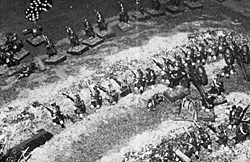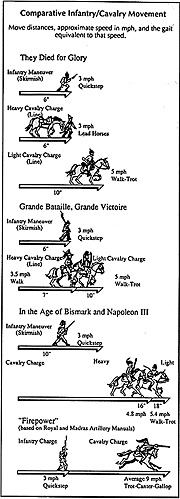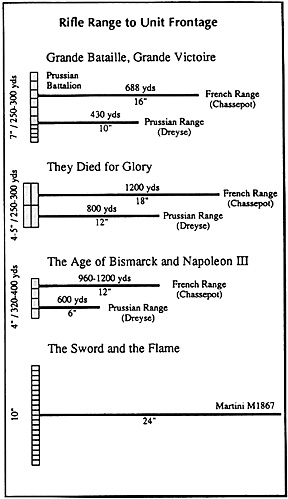Routinely THE COURIER staff, aka OLD COLONY WARGAMERS runs a game or two of their own version of Larry Brom's CHASSEPOT AND NEEDLE GUN. That's been going on for years, and like the occasional Mexico or 1859 scenario by Larry Brom himself combines great artistic merit of well painted 25mm or 30mm (roughly the same size)with somewhat stylized rules. I have also noticed several games in which infantry and cavalry are mounted four to a base (two by two) in 15mm but I haven't even been able to locate the events in my convention programs.
However, the major surge seems to be the result of Dave Waxtel and Brian Phillips promoting their respective interpretations on the HMGS circuit, and J.W. Brown promoting GBGV off to the west (in spite of my perhaps unflattering review.) The lively interest, along with some direct prompting from old wargame buddies like Ken Bunger has led me to undertake a review of these leading rule sets: THEY DIED FOR GLORY (TDFG) by Dave Waxtel and Robert Burke; GRAND BATAILLE GRANDE VICTOIRE (GBGV) by J.W. Brown; and IN THE AGE OF BISMARK AND NAPOLEON III (BNIII) by - chiefly - Brian Phillips.
Unlike my first review of GBGV I resolved to go beyond mere textual criticism. I resolved to actually play or conduct games with each rule set. This, in turn, gave me two fringe benefits: I got to do some wargaming, and I had people with whom to share some of the blame for at least some of my criticisms.
Jumbo Size Movement Chart (76K)
Realism: As a matter of taste, I like for wargames to be realistic in the sense that one wins or loses for believable historical reasons.
Table Scale: Not necessarily inherent to the above, but related to it, I look for the approximate relationship of weapon ranges to unit frontage in known formations, chiefly the particular army's habitual (or doctrinal)firing line. I have been pleased by recent published discussions of frontage and range with respect to WARFARE IN THE AGE OF REASON, which tends to lend the support of custom to this practice, for all that J.W.
Brown complained of it in his rebuttal to my review of GBGV. Thus, for example, my good friend Larry Brom's highly successful THE SWORD AND THE FLAME (TSATF - Nick Nascati's favorite rules and a staple of OLD COLONY among others) features one figure equals one man with 20 figure platoons firing Martini-Henry's for a maximum 24". We know that such a platoon in 1879 would, using the shoulder to shoulder bonus occupy a frontage of no more than 10yds (28" to a yard per file), and the figures might occupy 10".
Thus we are saying that the Martini, with a rated range of 1200yds, and an effective range of at least 900 yds, can fire a game range of 24yds. Conversely, we might surmise that our platoon's shoulder to shoulder frontage is 300yds, so it is really a very strong battalion (or a company armed with matchlocks.) I mention this not to aggravate Larry, who is absolutely impervious to such criticisms, but to give an example of a tact I will be taking with three at least simi-serious rule sets.
Cavalry, of course, is a particular weakness of mine, and when I look at these rules I will check to see if they respect Frederick's adage (stated in the 1757 regulations and confirmed in those of 1877) that cavalry should be able to gallop in line for 1,000 yards (per my 1936 cavalry manual, a manuevering gallop of 12mph versus a maximum of 3mph for a plodding foot soldier. Admittedly Frederick was an optimist.)
Simplicity: In spite of all this, game mechanics should be as simple as practical. Simplicity and lack of realism are not the same thing.
Diorama: Also, the game should have a pleasing diorama quality. Admittedly we are dealing with representative caricatures but it should have a nice balance to it's appearance. This, of course, is the most subjective of criteria.
Command Control: I should add that I am something of a primitivist on command and control, the very essence of modern conflict simulation. However, I recognize this as an inheritance from bygone ages in which highly competitive individuals (like Dave Geisz and myself) went at each other with relatively large armies. We expected to exercise multiple levels of command as long as we didn't move one force in response to sightings from another until couriers arrived, and a units officers didn't all get picked off. Both of my collaborators are more progressive in such matters. Bill Gray's comments to me about writing down a plan and sticking to it could have been uttered by J.W. Brown himself.
All that having been said, each of these rules has substantial strengths and some weaknesses in these areas. I will try to take these up as we go through the playtests.
I was fortunate in being able to line up Major Wilbur Gray and Richard (Rich) Lowe for these games. Major Gray is on active duty with the National Guard in the NCR, leaving his family in Pennsylvania, thus a temporary bachelor with time on his hands. He brings a well known reputation as a scholar of other periods of warfare with an unsuspected fascination for the era in question. Rich Lowe is a locally active gamer who happened, also without my prior knowledge, to have tried all three of these games in his effort to find the perfect set of Franco-Prussian rules.
To ensure that we would have armies to maneuver I dredged up some long dormant Franco-Prussian 30mm flats. Dick Bryant remembers them. He led these same Prussians in massed columns to bloody defeat around 25 years ago. Flats are not (as I once claimed) ideal for wargaming. However, by using slotted stands you can rebase figures for different rule sets. I didn't pack quite as many as I thought, so the first two scenarios were somewhat limited.
As a point of departure I used a loose interpretation of the 1870-1914 KRIEGSPIEL from COURIER #61. Since THEY DIED FOR GLORY is based on 50 to 1, I could only muster some 4.5 French battalions, two 4pdr batteries, 1 mitrailleuse battery, and a weak cavalry regiment (Aloys Ochel packed 10 rather than 12 horsemen to the box) against 5.5 somewhat larger Prussian battalions with three 4pdr batteries and the weak cavalry regiment. GRANDE BATAILLE, GRANDE VICTOIRE uses roughly 60 to one, so I was able to muster a full cavalry regiment on each side, with 7 Prussian battalions (2 grenadier, 2 musketeer, their respective fusiliers, and a jager battalion.) The French had an understrength brigade of 5 line battalions and a chasseur a pied battalion. Because GBGV while lowering the figure scale for other arms triples the representation for artillery, I had to make do by padding the gun crews and increasing the artillery frontage by a factor of three.
More Three Roads to Paris
Letter: Clarification for They Died for Glory (#65) Over the past two or three years I have noticed a substantial increase in the incidence of late 19th Century European wargames at HMGS East conventions. Obviously this is not my doing. It has been a long time since my Franco-Prussian theme year for THE COURIER stirred a flurry of activity. I had essentially stopped running NAPOLEON THE LITTLE games in favor of periods in which I have a quasi commercial interest. Also, my last scholarly venture on this period for THE COURIER on flags and formations of this epoch drew an above average NIQ (Non Interest Quotient in Volley Fire - ED). All the same, something was going on out there. It was not unusual for a convention to feature a dozen scenarios using four or five different rule sets in 15mm and 25mm representing European conflicts of the Second Empire era.
Over the past two or three years I have noticed a substantial increase in the incidence of late 19th Century European wargames at HMGS East conventions. Obviously this is not my doing. It has been a long time since my Franco-Prussian theme year for THE COURIER stirred a flurry of activity. I had essentially stopped running NAPOLEON THE LITTLE games in favor of periods in which I have a quasi commercial interest. Also, my last scholarly venture on this period for THE COURIER on flags and formations of this epoch drew an above average NIQ (Non Interest Quotient in Volley Fire - ED). All the same, something was going on out there. It was not unusual for a convention to feature a dozen scenarios using four or five different rule sets in 15mm and 25mm representing European conflicts of the Second Empire era.
 For all that, I did bring some intellectual baggage of my own to the battlefields. For the benefit of those not familiar with my prejudices, I will go over a few up front:
For all that, I did bring some intellectual baggage of my own to the battlefields. For the benefit of those not familiar with my prejudices, I will go over a few up front:
 Relative Movement: Even though none of us has concocted an entirely satisfactory treatment of time and distance, the effort is necessary. I look for relative movement of the different arms, classes, and formations compared to historical precedents. Thus, for example, columns should be more mobile than lines, horse than foot, etc. I'm open to a lot of arguments and rationale on these items but tend to look particularly on the relative speeds of the arms, weapon ranges, and the potential effects over distance.
Relative Movement: Even though none of us has concocted an entirely satisfactory treatment of time and distance, the effort is necessary. I look for relative movement of the different arms, classes, and formations compared to historical precedents. Thus, for example, columns should be more mobile than lines, horse than foot, etc. I'm open to a lot of arguments and rationale on these items but tend to look particularly on the relative speeds of the arms, weapon ranges, and the potential effects over distance.
Introduction
Review: They Died for Glory
Review: Grand Bataille Grand Victorie
Review: In the Age of Bismark and Napoleon III
General Issues
Rebuttals to Three Roads to Paris (#66)
Back to Table of Contents -- Courier #64
To Courier List of Issues
To MagWeb Master Magazine List
© Copyright 1994 by The Courier Publishing Company.
This article appears in MagWeb (Magazine Web) on the Internet World Wide Web.
Other military history articles and gaming articles are available at http://www.magweb.com